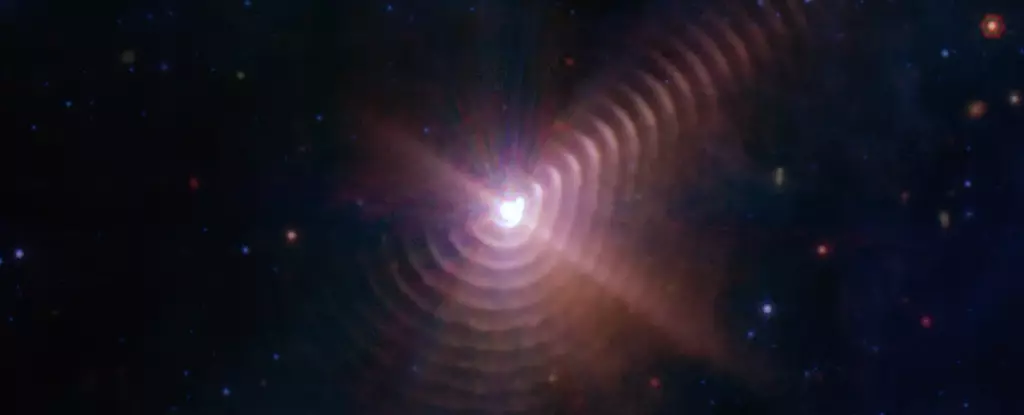Cosmic dust plays an essential role in the universe, serving as a crucial element in the formation of both rocky planets and the very foundation of life itself. Composed of carbon-rich particles among other materials, this dust originates from various stellar and cosmic phenomena. Despite its significance, cosmic dust poses a considerable challenge to astronomers. When observing celestial bodies with telescopes, the presence of this dust can obscure targets and complicate the gathering of valuable data. The James Webb Space Telescope (JWST) was developed precisely to penetrate the depths of cosmic dust through infrared imaging, thereby opening new avenues for understanding the complex processes occurring in space.
An interesting aspect of cosmic dust is its symbiosis with stellar activity, particularly in environments characterized by the collision of stellar winds. One such notable case is the Wolf-Rayet binary star system known as WR 140, situated approximately 5,000 light-years away in the Cygnus constellation. Recent studies using the JWST unveiled details regarding this binary star’s behavior, specifically how it generates an expanding series of carbon-rich dust rings.
The study of WR 140 offers an unparalleled opportunity to explore the intricate dynamics of dust formation in stellar environments. Research published in *Nature Astronomy* highlights the periodic and predictable nature of dust formation around WR 140, with distinct dust episodes occurring every 7.93 years during a phase known as periastron. This period is marked by the collision of stellar winds produced by the two massive stars in the system: a Wolf-Rayet star and an OB star. During these encounters, the winds collide with such force that they compress gas to create carbon-rich dust.
The chaotic conditions near WR 140 during these encounters serve as a natural laboratory to investigate the properties and composition of cosmic dust. Researchers acknowledged the complexities involved, stating that while the process contributes significantly to chemical enrichment in the interstellar medium, many details remain elusive. The predictable nature of WR 140 makes it an ideal target for in-depth studies, allowing scientists to form hypotheses regarding the conditions necessary for dust formation and its subsequent survival in the inhospitable cosmic environment.
New Insights from the James Webb Space Telescope
The JWST has revolutionized our understanding of cosmic phenomena, particularly in its ability to capture timely observations of objects undergoing rapid changes. Following initial observations taken approximately 5.5 years after the last periastron passage in 2016, the JWST revisited WR 140 about 14 months later, capturing astonishing images showing the rapid expansion of carbon-rich dust rings. This rapid evolution of dust molecules is especially remarkable given the general perception that cosmic events transpire slowly over millions or even billions of years.
Lead researcher Emma Lieb emphasized the significance of these observations, highlighting the marking of the dust shells’ extended motion within mere months rather than the timescales typically associated with astrophysical phenomena. The JWST’s data further confirms the reality of these circumstellar structures, providing astronomers with insight into the velocity at which dust is expelled and enabling them to track the observable transformations more closely.
Understanding the Future of WR 140
The continuous observation of WR 140 by the JWST has unveiled fascinating details about the cycle of dust production in this binary system. While some stars eventually transition into supernovae or collapse into black holes, WR 140 remains in its active dust-producing phase for the foreseeable future. The JWST’s advanced capabilities, especially its mid-infrared imaging through the Mid-Infrared Instrument (MIRI), allow scientists to delve deeper into the nature of the dust formations and the underlying processes driving their creation.
Interestingly, not all carbon-rich dust produced in WR 140 exists in easily observable rings. Some of the dust manifests as expansive clouds or individual particles spread across significant distances in space. This newly acquired knowledge paves the way for a richer understanding of how dust not only contributes to the fabric of galaxies but also serves as a fundamental building block for star formation and potentially, life itself.
The study of WR 140 extends far beyond the realm of dusty star systems; it essentially encapsulates the ongoing cosmic ballet of creation and destruction. The JWST’s findings on the expanding carbon-rich dust rings from this Wolf-Rayet binary system highlight the importance of such astronomical phenomena in shaping the universe. As humanity continues to observe and analyze these cosmic laboratories, we inch closer to comprehending how stellar interactions contribute not only to the generation of matter but also to the profound chemical enrichment necessary for the emergence of life as we know it. Going forward, the JWST’s role will be crucial in unraveling the complexities and mysteries of cosmic dust and its origins, leaving the door open for exciting future discoveries.

